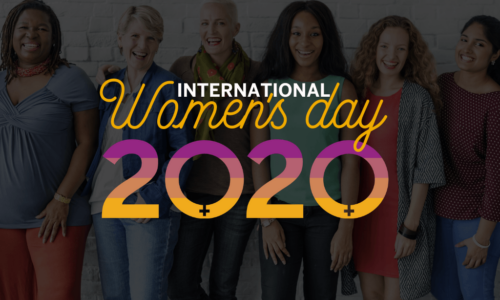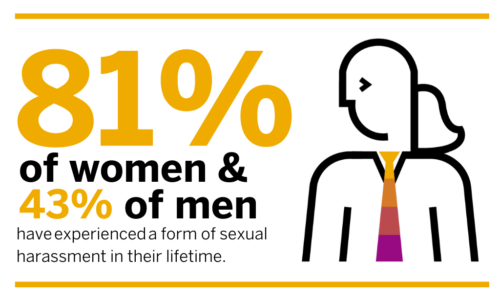International Women’s Day 2020: An Investment in Training is an Investment in Your People

Why should a culture of complicity grow until something terrible enough happens to stop it? Are high-profile, celebrity stories making it easier or more difficult for us to see the difference between right and wrong? In ideal world, calling out unacceptable behaviour would be a straightforward decision. But the reality is, this is a very complex decision. Existing working relationships can cloud judgement, values can misalign, and training might not be delivered consistently or clearly enough to create awareness around workplace harassment.
So, it’s clear that there’s still lots to be done. Let’s look at the facts, when it comes to sexual harassment in the workplace.
The workplace by numbers
In Australia, one in two women and one in four men experience sexual harassment during their lifetime.
This equates to 7.2 million Australians.
In the USA, the statistics are also staggeringly high. Nationwide, 81 percent of women and 43 percent of men have experienced a form of sexual harassment in their lifetime.
This affects around five million Americans every year.

And in the UK? A third of women in this study stated they wouldn’t know how to report sexual harassment in their workplace. And a fifth said that they’re too afraid to speak up.
So why are these numbers so low? How can you empower the workers in your organisation to act and call out unacceptable behaviour? And what role does workplace training play? Let’s dive in.
The consequences of speaking up
There’s any number of reasons why someone facing sexual harassment in their workplace – whether directed toward them or witnessed by them – would choose to remain silent.
- Fear of retaliation, job loss, or disbelief
- Uncertainty about the right course of action
- Gap between organisational values and actual behaviour
- Fear of repercussions to one’s reputation
- Unwillingness to engage in confrontation at work
Furthermore, in the USA, almost two thirds of accusers lose their jobs as a result of making a sexual harassment complaint. In fact, 68 percent of sexual harassment complaints in the USA include allegations of employer retaliation. There’s no doubt that sexual harassment in the workplace continues to be a pervasive problem, yet few organisations are successfully working to prevent it.
An organisation’s culture needs to encourage honesty and transparency. Leadership must give their employees an opportunity to call out unacceptable behaviour through training and policies. Otherwise, in an age of social media empowerment, employees can take this decision into their own hands. They’re just one tweet away from bringing their organisation’s reputation crashing down. Or, for lack of internal options, their feet will do the talking – people don’t always leave their role, they often leave their workplace culture.
A legal problem or a cultural problem?
The current legal process also has far-reaching implications for workers seeking retribution. While the chance of job loss is high, cash payouts aren’t. Many workplace sexual harassment cases, while legally plausible, don’t result in a cash benefit. Avoid legal processes in the first instance, by encouraging those in leadership roles to take ownership and appropriate action toward empowering their employees, as recommended by the EEOC and the AHRC.
In many organisations, the existence of deeply seated cultural issues also contributes to workplace harassment. Certainly, the introduction of Sexual Harassment laws in selected USA states, the Sex Discrimination Act in Australia, and harassment laws in the UK has given organisations incentive to reassess their workplace culture, to correct harassing behaviour and to introduce pro forma policies and training requirements. But training needs to be carried out with consistent, continuous steps toward changing workplace culture.
Training is not a one-stop, quick-fix solution. It’s a commitment to an effective learning culture, which will lead to better results. Keep in mind that often, when we feel pressure to change or agree with something, our unconscious bias is reinforced. But when we feel as though the choice to self-improve is our own, as though developing new skills and increasing our knowledge and awareness is our decision, our knowledge retention is so much stronger.
An investment in training, an investment in your future
Unfortunately, in many workplaces, there still seems to be a knee-jerk reaction to sexual harassment complaints. Many employers chose to turn a blind eye, refuse to admit there is an issue at play, or choose instead to blame the victim. There’s that little voice in the back of their mind whispering that sexual harassment complaints cost time and money, that they affect morale, productivity, and potentially the reputation of the organisation. So, a general reluctance to cooperate with the victim emerges. Employers are unwilling, or unaware of how, to implement strategies that will effectively reduce the risk of workplace harassment happening in the first place.
Although a wealth of research identifies best practice in sexual harassment training programs for the workplace, it still needs to be comprehensive. It needs to be consistent. And it needs to be believed from the top down.
Give your employees effective training and internal outlets, give them a chance to unify their voices and create a safer, more supportive culture. And positive, ground-breaking stuff like this will happen. A small group of employees from SAP Australia’s Melbourne Business Women’s Network decided to empower other employees affected by family violence. They banded together, petitioned their HR department, united their voices, and together said: “We won’t stand for this.” In January, a new FDV policy was introduced, as a direct result of empowered employees standing together for their colleagues.
This is a powerful reminder of what people can achieve if given a platform to be heard. Then, we can begin to make meaningful change.

The SAP Business Women’s Network in Melbourne, Australia, worked together to introduce a new FDV policy in their organisation.
Empowered employees and a healthier culture will open so many doors. Invest in workplace ethics training. Try something a bit different when it comes to reinforcing the knowledge gained through online training. Encourage your employees to watch Apple TV’s ‘The Morning Show’ and see them take inspiration from the women and men in that workplace, who actively take a stand on unacceptable behaviour. Because employees equipped with ethics have an awareness to approach other problems in their organisation without unconscious bias, to lift each other up and address unacceptable behaviour when it arises – without fear of retaliation. An investment in workplace ethics and anti-harassment training isn’t just an investment in avoiding future legal fees: it’s an investment in your brand, in your reputation, and in your people.





